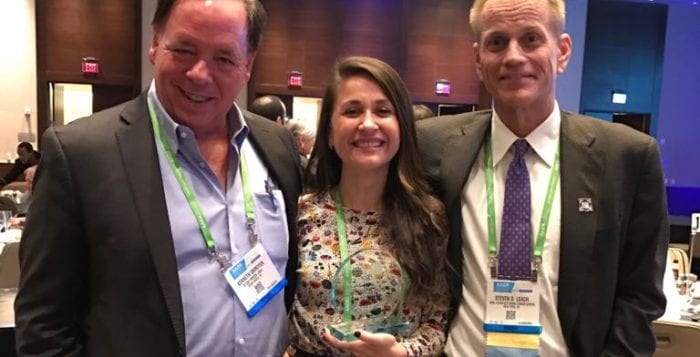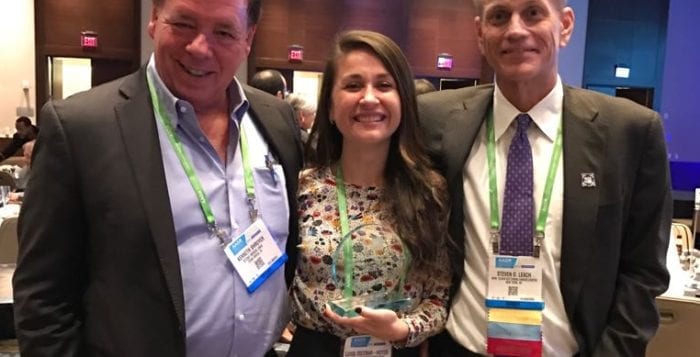By Daniel Dunaief
Stony Brook University has collected its first PanCAN award. Pathology Chair Kenneth Shroyer and Assistant Professor and Co-Director of the Pathology Translational Research Lab Luisa Escobar-Hoyos have earned a two-year $500,000 research grant from the Pancreatic Cancer Action Network.
The tandem has worked together for seven years on the protein keratin 17, or k17, which started out as an unlikely participant in pancreatic cancer and as a molecule cancer uses to evade chemotherapy.
Shroyer and Escobar-Hoyos were “thrilled to get the award,” said Shroyer in a recent email. “While we thought our proposal was very strong, we knew that this was a highly competitive process.”
Indeed, the funding level for the PanCAN grants program was between 10 and 15 percent, according to PanCAN.
The grants review committee sought to identify projects that “would constitute novel targets for treating pancreatic cancer,” said Maya Bader, the associate director of scientific grants at PanCAN.
“Given that k17 represents a potential new target, the committee felt the project was a good fit with exciting potential to meet this goal. We are thrilled to welcome Dr. Shroyer to the PanCAN grantee research community and look forward to following both his and Dr. Escobar-Hoyos’ contributions to the field,” she said.
Escobar-Hoyos explained that she and Shroyer hope “this work will shed scientific insight into potential novel ways to treat the most aggressive form of pancreatic ductal adenocarcinoma,” which is the most common type of pancreatic cancer.
Although they are not sure if their approaches will be successful, she believes they will provide information that researchers can use to “further understand this aggressive disease.”
Thus far, Shroyer and Escobar-Hoyos have focused on the role of k17 in pulling the tumor suppressor protein p27 out of the nucleus into the cytoplasm, where it is degraded. More recently, however, they have explored how the k17 the tumor produces reprograms the cancer metabolome.
They have data that suggests that k17 impacts several dozen proteins, Escobar-Hoyos suggested. If the tumors of patients express k17, around half the protein content will go to the nucleus of the cell.
In addition to understanding what k17 does when it enters the nucleus, Escobar-Hoyos and Shroyer are testing how they might stop k17 from entering the nucleus at all. Such an approach may prevent pancreatic cancer from growing.
Shroyer and Escobar-Hoyos are working with a graduate student in the lab, Chun-Hao Pan, who is testing molecular pathways that might make pancreatic cancer more resistant to chemotherapy.
Dr. Yusuf Hannun, the director of the Stony Brook Cancer Center, was pleased that his fellow Stony Brook scientists earned the PanCAN distinction.
“It is an important award and speaks to our growing significant efforts in research in pancreatic cancer,” he said, suggesting that the research could have important benefits for patients battling with pancreatic cancer.
“This defines at the very least a novel and important biomarker for pancreatic cancer that can also extend into novel therapeutic approaches,” Hannun said. This type of research could enhance the diagnostic process, allowing doctors to subtype pancreatic cancers and, if the pathways become clearer, enhance the effect of chemotherapy.
The funds from the PanCAN award will support experiments in cell culture and in animal models of pancreatic cancer, Shroyer explained.
Shroyer has teamed up with numerous researchers at Stony Brook and Cold Spring Harbor Laboratory on this work.
As proof of principle for one aspect of the proposal, he accessed chemosensitivity data from pancreatic cancer organoids. Hervé Tiriac, a research investigator who works in David Tuveson’s lab at CSHL, generated these organoids from SBU pancreatic cancer specimens.
In addition to their work with organoids at CSHL, Shroyer and Escober-Hoyos benefited from their collaboration with SBU’s Ellen Li, a professor of medicine, who ensured patient consent and specimen collection.
Going forward at Stony Brook University, the key collaborator for this project will be Richard Moffitt, an assistant professor in the departments of Biomedical Informatics and Pathology.
Shroyer described Moffitt as an “internationally recognized leader in the field of pancreatic cancer subtyping” who is working to understand better how k17 could serve as a prognostic biomarker.
At the same time, Wei Hou from the Department of Family, Population and Preventive Medicine will provide biostatistical support throughout the course of the project.
PanCAN, which has donated $48 million to support pancreatic cancer research, awarded nine grants this year in the United States, Canada and France, for a total contribution of $4.2 million.
The other scientists include Andrew Aguirre from the Dana-Farber Cancer Institute, Scott Lowe, who had previously worked at Cold Spring Harbor Laboratory and is now at Memorial Sloan-Kettering Cancer Center and George Miller at New York University School of Medicine.
Previous recipients of PanCAN awards have been able to leverage the funds to attract research dollars to their work.
Grantees who had received $28.2 million from 2003 to 2015 went on to receive $311 million in subsequent funding to support their pancreatic cancer research, according to PanCAN. That means that every dollar awarded by PanCAN converts to $11.01 to fund future research aimed at understanding, diagnosing and treating pancreatic cancer, according to Bader. Most of the subsequent funding comes from government sources.
PanCAN award recipients have published research that other scientists have cited more than 11,000 times in other papers published in biomedical journals. This means “other researchers are reading, learning from and building upon our grantees’ work,” Bader added.






